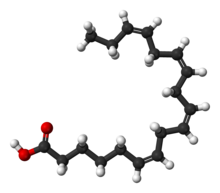
| |
| Names | |
|---|---|
| Preferred IUPAC name
(6Z,9Z,12Z,15Z)-Octadeca-6,9,12,15-tetraenoic acid | |
| Identifiers | |
3D model (JSmol)
|
|
| ChEBI | |
| ChEMBL | |
| ChemSpider | |
| ECHA InfoCard | 100.127.224 |
PubChem CID
|
|
| UNII | |
CompTox Dashboard (EPA)
|
|
| |
| |
| Properties | |
| C18H28O2 | |
| Molar mass | 276.420 g·mol−1 |
| Density | 0.9334 g/cm3 (15 °C) |
| Melting point | 200 °C (392 °F; 473 K) decomposition |
Except where otherwise noted, data are given for materials in their standard state (at 25 °C [77 °F], 100 kPa).
| |
Stearidonic acid (SDA: C18H28O2; 18:4, n-3) is an ω-3 fatty acid, sometimes called moroctic acid.
Biosynthesis[edit]
It is biosynthesized from alpha-linolenic acid (ALA: C18H30O2; 18:3, n-3) by the enzyme delta-6-desaturase, which removes two hydrogen (H) atoms.
Stearidonic acid is a precursor to eicosapentaenoic acid.[1]
As it is a precursor to other fatty acids, there has been efforts to enhance the content off stearidonic acid in various crops, such as soybeans.[2]
SDA is also a precursor to N-acylethanolamine (NAEs).[3][4] Natural sources of this fatty acid are the seed oils of hemp, blackcurrant, corn gromwell,[5] and Echium plantagineum, and the cyanobacterium Spirulina. SDA can also be synthesized in a lab. A GMO soybean source is approved by the European Food Safety Authority.[6]
See also[edit]
References[edit]
- ^ Calder, Philip C. (2012). "Mechanisms of Action of (N-3) Fatty Acids". The Journal of Nutrition. 142 (3): 592S–599S. doi:10.3945/jn.111.155259. PMID 22279140.
- ^ Garg, Monika; Sharma, Natasha; Sharma, Saloni; Kapoor, Payal; Kumar, Aman; Chunduri, Venkatesh; Arora, Priya (2018). "Biofortified Crops Generated by Breeding, Agronomy, and Transgenic Approaches Are Improving Lives of Millions of People around the World". Frontiers in Nutrition. 5. doi:10.3389/fnut.2018.00012. PMC 5817065. PMID 29492405.
- ^ Galasso, Incoronata; Russo, Roberto; Mapelli, Sergio; Ponzoni, Elena; Brambilla, Ida M.; Battelli, Giovanna; Reggiani, Remo (2016-05-20). "Variability in Seed Traits in a Collection of Cannabis sativa L. Genotypes". Frontiers in Plant Science. 7: 688. doi:10.3389/fpls.2016.00688. ISSN 1664-462X. PMC 4873519. PMID 27242881.
- ^ PubChem. "Stearidonic acid". pubchem.ncbi.nlm.nih.gov. Retrieved 2022-11-22.
- ^ "Corn Gromwell". NIAB. Archived from the original on 2011-07-04.
- ^ "Scientific Opinion on genetically modified soybean MON 87769". European Food Safety Authority. 2014-05-16. Retrieved 2019-02-18.
Well, that’s interesting to know that Psilotum nudum are known as whisk ferns. Psilotum nudum is the commoner species of the two. While the P. flaccidum is a rare species and is found in the tropical islands. Both the species are usually epiphytic in habit and grow upon tree ferns. These species may also be terrestrial and grow in humus or in the crevices of the rocks.
View the detailed Guide of Psilotum nudum: Detailed Study Of Psilotum Nudum (Whisk Fern), Classification, Anatomy, Reproduction